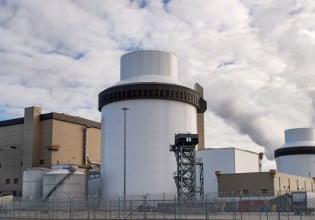Using Annual Energy Density to Determine Energy’s Environmental Impact
A study introduces the concept of annual energy density to measure the environmental footprint of electric power generation.
There is an interconnection between the climate crisis, the environmental crisis, and the energy crisis. One cannot be helped without considering the effect on another.
Interconnection between climate, environment, and energy. Image used courtesy of Adobe Stock
Addressing the climate crisis requires reducing greenhouse gas emissions, which means transitioning away from fossil fuels and towards renewable energy sources, such as solar, wind, and geothermal energy. This transition to clean energy can help mitigate both the climate and energy crises. However, this transition must be done sustainably and responsibly to avoid exacerbating the environmental crisis by, for example, causing habitat destruction or pollution associated with renewable energy production.
To prepare for the increase in electricity expected by 2050 without risking further climate and environmental damage, researchers have considered the most effective energy solution for global large-scale electricity generation.
What is the Most Land-Efficient Renewable Energy?
The situation we find ourselves in requires some serious forward-thinking. Simply advocating for increased power generation to satisfy demand and proceeding to construct additional power plants can lead to adverse ecological consequences. Preserving biodiversity represents a crucial element in maintaining a sustainable planet.
A study by the Norwegian University of Science and Technology and the Grenoble Institute of Technology introduces the concept of annual energy density as a metric to measure the environmental footprint of electric power generation.
A total of 870 power plants ‒ wind, solar, hydro, and nuclear ‒ were analyzed.
The research reveals a sobering reality that the world is headed towards a sixfold increase in environmental encroachments by 2050 if we continue to follow the International Energy Agency’s (IEA) net-zero emissions scenario. This means that resolving the climate crisis may worsen the environmental situation seriously unless we alter our current energy policies.
Assuming the world is successful in achieving net-zero emissions per the IEA’s scenario, electricity production for 2050 projections will require an area of land that is 1.5 times the size of India.
Greenhouse gas emissions. Image used courtesy of Adobe Stock
The expansion of human activity across the planet has already exceeded sustainable limits. The United Nations Intergovernmental Science-Policy Platform on Biodiversity and Ecosystem Services (IPBES) has underscored the critical importance of safeguarding nature to preserve global biological diversity.
It’s Not Trees
Bioenergy, which involves burning trees for energy, is a popular renewable energy source in some regions for heating, cooking, and transportation, but is the worst alternative.
It requires a large amount of space, using 878 square kilometers to generate one terawatt hour, which is insufficient to meet even a quarter of the energy needs of New York City. This makes bioenergy the least land-efficient solution.
It’s Not Wind, Either
According to the study, bioenergy is followed closely by onshore and offshore wind. Onshore wind power also has similar problems, despite being the second most dilute source of power generation among a sample of 148 onshore wind farms.
However, the study notes there are limitations to the assumptions made, as the calculations considered the total wind farm distribution area, including areas between wind turbines that lie empty but could be used for grazing, agriculture, and recreation. Additionally, high land requirements for wind power have implications for the need for materials and infrastructure, potential indirect effects on wildlife, and the degradation of landscapes. Technological improvements such as wake steering could enhance wind power performance in the future.
Nuclear and Hydropower
One of the key findings challenges the conventional wisdom that solar is the most energy-dense alternative, stating hydropower is, in fact, the most land-efficient renewable energy source globally.
The research found that hydropower is the most energy-dense renewable source worldwide, except in regions where the topography does not favor hydropower generation or where solar power has a higher performance than the global average.
The annual energy density standard deviation for hydropower ranged from 0 to 1.67 TWh/km2, with a high upper standard deviation similar to the lower standard deviation of nuclear power but far higher than natural gas.
According to the study, nuclear power boasts the highest spatial energy density compared to all other energy sources.
Nuclear power has the potential to provide the entire world with emission-free energy after the fossil fuel era in an area only half the size of Norway's Viken County or half the size of the U.S. state of Vermont.
Comparing the land use of nuclear power with that of onshore wind power, the former utilizes only 0.3% of the latter's land area, which amounts to 350 times less usage of land. These figures are particularly significant given the projected environmental crisis by 2050.
An energy transition solely relying on nuclear power could save 99.75% of environmental encroachments in 2050, even allowing for remediation of the already incurred environmental damage.
Why Not Solar?
Although solar power has been effective in facilitating the transition towards clean energy, it is not as efficient as other energy sources in terms of land use when addressing the environmental crisis.
The energy generated from sunlight is relatively low compared to the land area required to generate a significant amount of electricity.
In addition, the efficiency of solar panels can be affected by weather conditions and the angle and position of the sun, which can limit their output. Therefore, large land areas may be needed to install sufficient solar panels to generate enough energy to meet the demands of a given population.
Could Nuclear Power Become Renewable?
Nuclear power has faced a popularity issue for years, but it may be considered renewable in the long term due to obtaining uranium from the sea and reusing used uranium with new technology.
Recent studies suggest nuclear power could become a desirable neighbor, providing supply security and job opportunities for local communities.
The three crises of climate, environment, and energy are interconnected and must be addressed together. While there has been a focus on climate solutions, the importance of environmentally smart solutions has been overlooked. It is crucial to recognize the role of nature conservation and restoration in mitigating climate change. The study highlights the importance of land efficiency, with nuclear power being the most efficient option.








